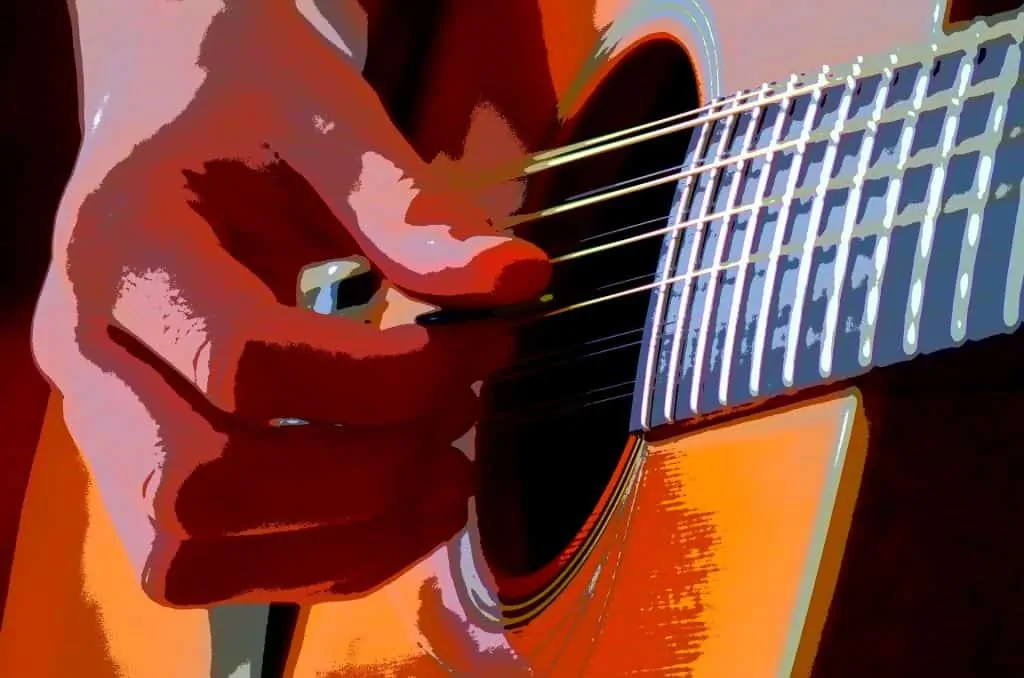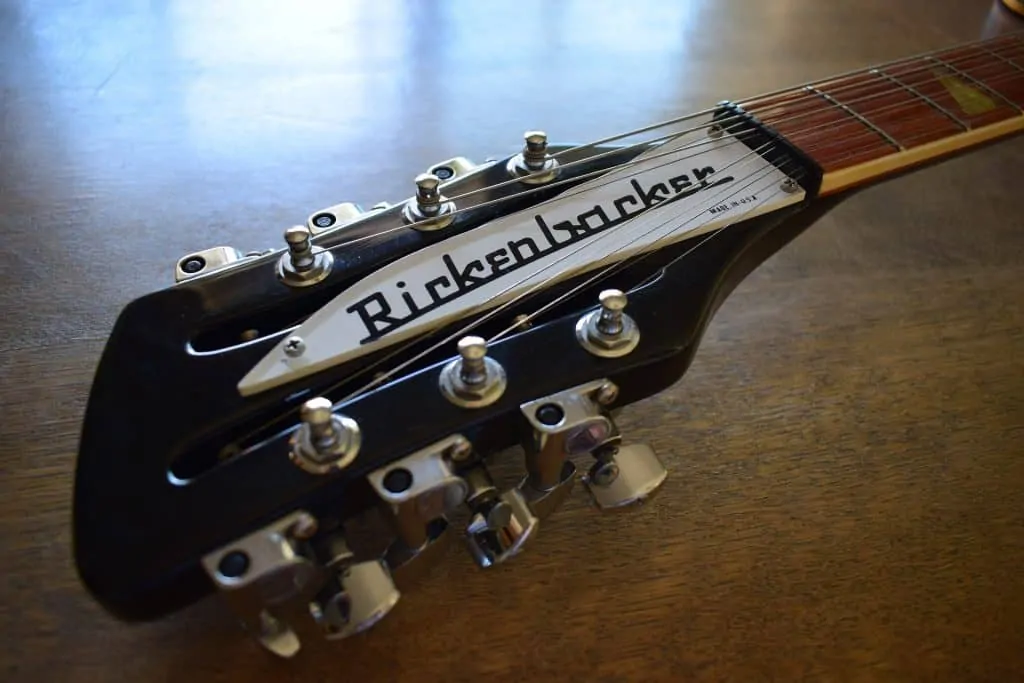The gleaming, shimmering sounds of 12-string guitars have captivated listeners for decades. Whether acoustic or electric, there’s just something special about a 12-string guitar that makes it perfect for an incredibly broad range of uses.
This guide walks you through everything you need to know to play 12-string guitar. Though it may be equivalent in most aspects to a traditional six-string model, the small differences can make for a rocky transition between the two. Read ahead to shorten your learning curve and maximize your 12-string skills more quickly.
12-string guitars have six “pairs” of two strings each.
Contents
What is a 12-String Guitar?
Long before 12-string electric guitars became popular in rock music, acoustic 12-strings were a staple of the folk music scene. The extra power and resonance made 12-strings popular with folk artists — these guitarists often played without amplifiers. The shimmer and jangle also created a more appealing counterpart to each singer’s voice. For solo acoustic concerts, 12-strings held an undeniable advantage.
With the dawn of the electric guitar age in the 1950s and 1960s, companies like Rickenbacker and Danelectro began manufacturing electric versions of acoustic 12-string guitars. Though they were no longer necessary for their added volume, electric pickups could detect more of the unique choruses and vibrations in 12-string guitars. Over time, the 12-string sound became firmly entrenched in rock and roll history.
The 12-string guitar, despite its name, doesn’t actually contain 12 strings tuned to all different notes like seven- and eight-string guitars. In fact, six of the strings are the exact same ones as on a regular guitar. The other six are each “paired” with their corresponding string from the original set of six. The paired strings are tuned one octave above the standard string on the lower four strings, and tuned to unison on the top two strings.
Unlike other extended-range guitars, 12-string guitars don’t open up any new notes on the fretboard. Instead, their appeal comes from the added resonance and jangle of the extra six strings. Because their necks and bodies are close to the same sizes as six-string guitars, 12-string guitars also have a much shorter learning curve.
12-string guitars can be played in a very similar manner to classic six-string axes: just place your finger down on the fretboard so that it covers both the original and the paired string at once. Otherwise, everything is tuned and maintained the same way as a six-string guitar is.
Sound of a 12-String Guitar
Because of the extra strings, 12-string guitar models are often described as “bright” and “shimmering.” The surplus set of strings on the guitar creates a sort of natural chorus effect: it doubles the sound in an organic, imprecise manner. That extra heft makes 12-string guitars great for rhythm players who need a fuller, rounder sound as well as lead players who need a chiming top end to cut through a mix.
12-string guitars are also known for their additional harmonics and overtones. Because there are double the strings ringing out when compared with a six-string guitar, 12-string instruments produce a more harmonically rich sound. If you listen to a 12-string, you’ll also hear more overtones in the final sound. These are the notes besides the fundamental note that your guitar produces when you pluck a string. Flatwound strings, like the classic Pyramid strings used by the Beatles, can change the tone and resonance of a 12-string towards a more “vintage” sound.
Certain 12-string models may grant players greater sustain than six-string guitars. The increased vibration helps sounds carry for longer than they might otherwise. It also doesn’t hurt that many of the most famous 12-string guitars are hollow-body or acoustic instruments.
Though hollow and semi-hollow guitars often have less sustain that solid-body instruments, they offer woody resonance and warmth that highlights the sustain of the 12 strings. Pure acoustic 12-string guitars are also popular — Taylor’s 150e 12-string is an affordable example of the company’s exceptional acoustic 12-string guitars.
A close-up look at the tuning setup on a Rickenbacker 12-string guitar.
Tuning and Stringing a 12-String Guitar
Though they’re far more of a pain to tune than normal axes, 12-string guitars follow the exact same tuning rules as six-string ones. Each pair string is tuned to resonate with the standard string. Like we mentioned above, the lower four strings have pairs an octave higher, while the top two strings are doubled with strings at the same pitch.
Certain 12-string guitars follow different arrangements, however. Standard 12-string guitars place the higher string on top — meaning that, if you strum down, you’ll strike the “pair” string first. There’s only one major exception to this setup.
Rickenbacker 12-Strings
Rickenbacker guitars are some of the most famous electric 12-strings ever. The Los Angeles company strings its 12-strings with the standard string coming first. If you strum down on a Rickenbacker 12-string, you’ll hear a sound that’s much closer to that of a standard guitar. Hitting all of the paired strings requires precise strumming technique as well as crisp, smooth playing.
Rickenbackers are also outliers in terms of their tuning peg setup. Most 12-string guitars, whether electric or acoustic, simply double the number of tuners on the headstock. Rather than three pegs on a side, 12-string guitars have six. This keeps everything clear and in plain view of the player, though it elongates the headstock and places a lot of tension towards the end of that thin piece of wood.
On the other hand, Rickenbackers utilize a unique system of six paired tuning keys. The standard set of six pegs remains unchanged from the company’s six-string guitars; the only difference is the addition of a second set of six tuners nestled beneath the first pair of six. Running the secondary tuners at a different angle to the original ones (parallel to the neck rather than perpendicular to it) keeps the setup tidy and organized.
The unorthodox tuning setup has helped make Rickenbackers much more popular than their counterparts; it’s far easier to tell what string you’re tuning on a Rickenbacker 12-string than on competing models with six pegs crammed into a line.
Furthermore, their pairing method allows Rickenbacker to use the same headstock shape for their 12-string models as for their six-string guitars. By reducing the length of the headstock, Rickenbacker alleviates some of the extra tension and wear on the fragile neck of the instrument.
Once you figure out which string you’re tuning and arrange the strings in the right order (whether the standard string is on the top or bottom of the pair is up to you), the rest of the process is pretty straightforward. You’ll only need to watch out for one major difference: the neck tension.
You must pay extra attention to the neck on your 12-string guitar; too much tension can warp or snap the wood!
Neck Tension on 12-String Guitars
The additional six strings on 12-string guitars exert much more tension on the neck and body of the guitar. This is particularly true for acoustic guitars, which feature thinner soundboards and more delicate bracing. If you’re tuning a 12-string guitar, you should avoid imbalancing the neck by removing too many strings from one side at a time.
Likewise, taking all of the strings off of a 12-string at once is too drastic a change for many necks to handle. The sudden drop in tension can cause issues with your guitar’s neck, ranging from warping to pulling and cracks.
You’ll also need to pay extra attention to the high octave G string. Because this is the highest string on the entire guitar, it’s under the most tension of any string. If you’re not careful, you can easily snap this string while trying to tune it to pitch.
Heavier gauge strings will resist breaking more effectively. You should also tune this string gradually; keep the tension as consistent as possible and refrain from using a string winder to accelerate the process. Whenever you work with strings prone to breaking, keep one hand loosely placed over the neck to prevent flying strings and wear proper eye protection gear.
Tune your 12-string guitar one string at a time, replacing each string as quickly as possible once you’ve cut the old one off. The lack of space between the tuning pegs may force you to cut one or two extra strings at a time to free up enough space to insert the new string. Just remember to keep the tension as balanced on both sides of the neck as possible and don’t cause any jarring shifts to the neck by cutting off all of the strings.
You’ll find that the tuning and re-stringing process grows easier with experience. It may take twice as long to re-string a 12-string guitar, but the otherworldly tones are well worth the extra hassle.
Neck width is one major difference between six- and 12-string guitars.
Playing a 12-String Guitar
Fundamentally speaking, a 12-string guitar can be played in the same manner as a standard axe — that is, you could swap in a 12-string for all of the parts you normally play with just six strings and it would work just fine.
However, treating a 12-string guitar as a “replacement” for a conventional instrument ignores the 12-string’s natural strengths. Accordingly, many players throughout the history of the guitar have built their style around the unique 12-string sound. Thanks to a host of factors, the 12-string is often played in its own distinctive style apart from six-string guitars.
If you’re learning to play 12-string guitar, you should make an effort to study the traditional styles and techniques associated with the instrument.
Most guitarists have some prior experience with six-string guitars before they ever pick up a 12-string model. Any knowledge you do have will carry over flawlessly — you certainly won’t need to re-learn the basic aspects of playing! Twelve-string guitarists, though, have developed a couple of independent techniques to help master the quirks of their instrument. Be prepared to make slight tweaks and finer adjustments to your mechanics when playing a 12-string.
Techniques
Though 12-string guitars are very similar to six-string instruments in terms of body size and neck shape, there are a couple of key differences. These quirks and oddball features give rise to the characteristic set of techniques many 12-string players are intimately familiar with.
Some of these tricks focus on your fretting hand, while others are concerned with your picking and arm mechanics. Keep all of these tips in your mind to make the transition from a six- to a 12-string guitar as seamless as possible.
To accommodate the extra strings, 12-string guitar necks are slightly wider; many players aren’t used to the extra heft when they first pick up a 12-string. Depending on your gear, you may also need to buy new accessories to fit your 12-string guitar. Taylor’s 12-string capo, designed for nylon-string guitars, is a good example.
The extra strings also present a challenge for guitarists. String spacing between the pairs varies according to each manufacturer; they’re always close enough together to be pressed down with one finger at the same time. If the strings on your model are paired close enough together to use the callussed tip of your fingers, you can continue to play the same way as you might a six-string.
Fretting
However, oftentimes guitarists struggle to fret both strings with one finger at the same time. Lots of paired strings are prone to buzzing or don’t ring out at all. To combat this problem, 12-string guitarists often adopt a flatter fretting technique. Rather than pressing down on the strings with the very tip of their finger, they flatten their hand a bit and fret the strings with a larger portion of their finger.
The extra surface area ensures that that both the standard and the paired string ring out correctly — you just need to make sure not to accidentally mute any other strings on the sides! Maintain proper hand position and don’t let the rest of your fingers or palm slump over the fretboard.
Picking
On the picking hand, 12-string guitarists often notice the presence of the extra strings when they strum. Twelve-string guitars tend to feel stiffer and may present a bit more resistance against your pick.
Because of the extra strings, 12-string guitarists need to ensure that they don’t accidentally skip any as they play. To achieve the full sparkle and glimmer that your 12-string is capable of, you’ll need to practice strumming all 12 strings with control and precision. Keeping a dedicated and consistent practice routine will help you develop this skill more quickly.
Remember to move your wrist and hand as you strum; don’t rely only on your elbow and shoulder to carry all of the work! The more compact your strumming motion, the more accurate you’ll be with both chord progressions and single-note lines.
Rickenbackers are some of the most famous electric 12-string guitars ever made. George Harrison, Roger McGuinn, and Peter Buck all used Rickenbackers!
Famous 12-String Guitar Players
The 12-string guitar has enjoyed a distinguished place in guitar history, both in rock and other associated genres. These are some of the most famous 12-string enthusiasts in that history; their innovations and techniques are largely responsible for shaping the 12-string guitar into the instrument it is today.
A list of famous 12-string guitar players might seem out of place in a guide about playing 12-string guitar. This list is designed to help you find some inspiration from past 12-string guitar legends.
These players, along with some others, have created the majority of the musical vocabulary for the 12-string guitar in modern music. If you’re struggling to find inspiration or aren’t sure how to use a 12-string guitar in your music, listening to these players might help you gain some new perspectives and techniques for your own playing style.
Roger McGuinn
Roger McGuinn is most famous for his association with California rock band The Byrds. Among the guitar community, however, he’s widely known as one of the first adopters of the 12-string electric guitar.
McGuinn, like many 12-string players, was particularly fond of chord-based melodies. These simple, direct inventions would become extremely popular as McGuinn powered The Byrds. Take a listen to the song “I’ll Feel a Whole Lot Better” and notice how the 12-string rhythm guitar moves the pulse of the song forward.
Even when not ripping off a tasty solo (like the one in the song above), McGuinn was the rhythmic heart of his band. With his 12-string Rickenbacker fed through multiple compressors. He was able to create clear, upfront rhythm parts which blended together with his lead guitar work and the vocal melodies.
Beyond his playing technique, McGuinn also created some incredibly distinctive tones thanks to his reliance on compressors. When in the studio, he would often run his Rickenbacker through a pair of compressors before playing through his amp. In recent years, McGuinn has endorsed the JangleBox compressor to achieve his signature sound.
The result is a “squeezed” and punchy tone that’s instantly recognizable in any Byrds song. Because the compression evens out dynamic difference between notes, it also serves to emphasize the paired strings on the guitar.
Even if they might not be as loud when played on their own, the compressor places those extra strings on an equal sonic playing field with the standard six. It makes the 12-string sound even more vibrant and unique than normal.
McGuinn’s warbly, punchy 12-string work with The Byrds inspired hundreds of other players who would later go on to have successful careers in their own light. It’s impossible to overstate his influence on the next generation of 12-string guitar enthusiasts; his presence is still felt even today.
George Harrison
Though McGuinn and The Byrds may have been one of the first bands to rely nearly exclusively on the electric 12-string guitar, the Beatles’ George Harrison actually began using the instrument first. After Rickenbacker president F.C. Hall gifted him a prototype model in 1964, Harrison went on to play the instrument in plenty of historic recordings.
Out of all those songs, Harrison’s 12-string is most prominent in “A Hard Day’s Night.” Listen to how Harrison strums the opening chord, relying on his guitar’s sustain and harmonics to carry the weight of the song. Even though it’s only one chord, it’s a masterclass in 12-string technique — the tone and character he achieves simply wouldn’t be possible with a six-string axe.
Beyond the single-chord punch of “A Hard Day’s Night,” Harrison also used his 12-string for more involved lead lines on tracks like “If I Needed Someone.” In fact, Harrison based this riff around the central guitar figure in the Byrds’ cover of “The Bells of Rhymney.”
Notice how the vast majority of the song uses only one chord: an A major chord, played in a D shape by using a capo on the fifth fret. The added jangle and chime of the 12-string guitar supplies enough variation and character to keep the rhythm fresh and intriguing.
Though George Harrison is most associated with a variety of six-string guitars, his 12-string style proved massively influential for generations of musicians after him. Any new 12-string guitarist ought to take a close look at his work and style to develop their own playing on the instrument.
Peter Buck
After Harrison and McGuinn blazed a trail for the 12-string guitar in popular music, R.E.M.’s Peter Buck expanded its sonic possibilties through his work in the 1980s and ‘90s. Much of Buck’s trademark style evolved out of his position as the sole guitarist in the band — without a second player to lean on, he used the extra shine and chorus of a 12-string to fill out the space.
Buck is known for his use of arpeggios and melodic rhythm lines. Though he often plays single-note passages rather than block chords, his 12-string Rickenbacker projects a full-bodied feel. These parts emphasize the texture of a song, rather than any of his own chops. Listen to his glistening introduction to R.E.M.’s “Pretty Persuasion”:
Buck also favors simple chords — he often uses standard major and minor voicings played low on the neck. To play like him, try shifting your fingers around the chords slightly to create melodies. Play those melodies in lieu of traditional rhythm parts to highlight the 12-string guitar’s sweet, chiming sound.
Though six-string guitars are more familiar, 12-string models create new and unique possibilities for your sound.
Summary
The 12-string guitar is one of the most popular variations on the standard six-string axe. It’s been one of the most influential devices in the development of rock and roll, classic rock, and indie rock as well.
While it’s easy to play for guitarists familiar with normal models, it still offers a tone and feel that’s completely unique. If you’re considering purchasing a 12-string guitar, take your time and experiment with all of its different quirks — you might just find that it becomes your favorite model!







